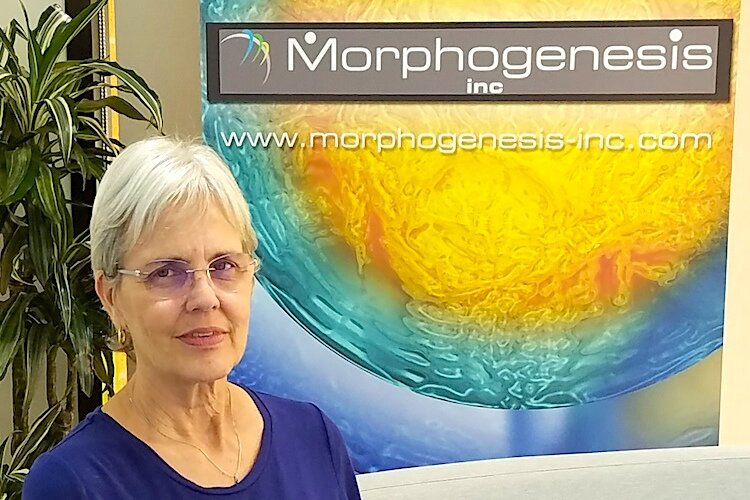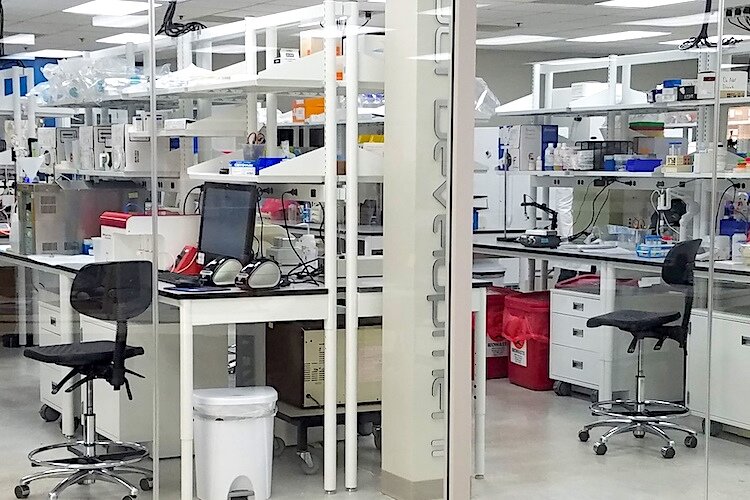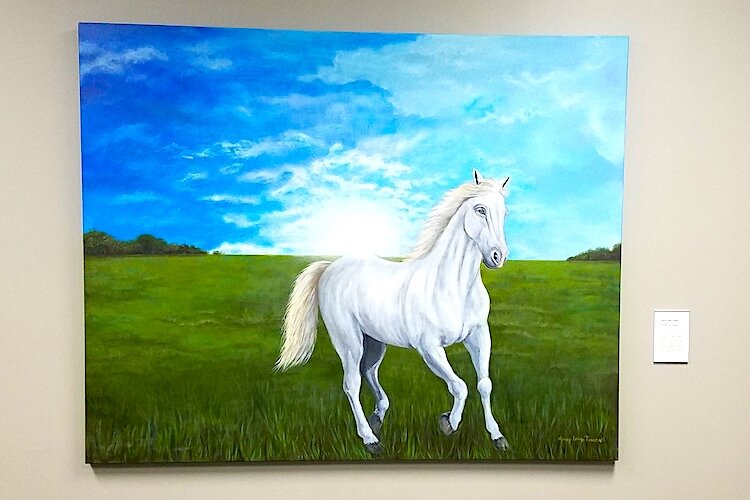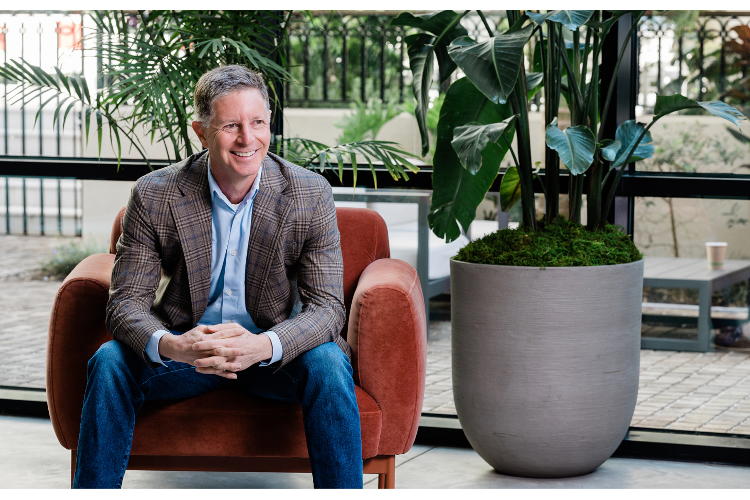Cancer research company in Tampa nears breakthrough
Morphogenesis, a Tampa cancer research company, plans a Phase II initiative that will focus on skin cancer and the ability to perform a direct injectable into melanoma tumors.
A scientist on the verge of a major breakthrough in the war on cancer is quietly working away with a team of researchers in a laboratory in the heart of Uptown Tampa’s innovation district.
Dr. Patricia Lawman and her company Morphogenesis, a clinical-stage company developing novel cell and gene therapies, is currently conducting a first-in-human clinical study for cutaneous melanoma.
If all goes well, the start of 2020 could be the beginning of a new era for Morphogenesis and the realization of a long-held goal for Lawman and her husband, Michael. Begun in November of 2018, the study’s primary conclusion date is anticipated soon — possibly in February.
But to better understand just how far the Lawsons have come, let’s start at the beginning.
The journey to this point began with a meeting on a plane while returning to campus from a spring break trip to Key West. Pat, then a grad student at the University of Florida struck up a conversation with a charming seatmate who was on his way to UF to interview for a faculty position. Michael Lawman and Patricia Thibos met again in Gainesville at a party for a colleague and realized they were mutually attracted to each other, but Michael was now a member of the UF faculty; Pat and Michael needed permission from his department chair to start dating. Permission was granted.
Graduating from the University of Florida with a Ph.D. in Immunology and Molecular Biology, Pat was recruited to the Walt Disney Memorial Cancer Institute, where she served as Division Director of Cancer Molecular Biology focusing on gene targeting, gene therapy, gene delivery, and universal stem cell projects. Michael was recruited at the same time as Director of Cancer Research.
When the Director of the Walt Disney Memorial Cancer Institute retired, the Lawmans negotiated the rights to retain the research they had developed. They also recruited eight of their colleagues to join them in moving en masse to the University of Florida’s Biotech Incubator. Morphogenesis was born.
They supported themselves by winning two Small Business Innovation Research Grants allowing the research they had begun at Disney to continue. By the time the grant money ran out so did their contract at the incubator.
They needed an immediate infusion of cash but the financial wheels of bio-science funding turn slowly. Pat and Michael tried to keep going by having everyone work virtually but without a base of operations and financial compensation, the team broke up.
Resolute, Pat and Mike packed up all of Morphogenesis’s equipment and files, stored them in a garage, and set off on a detour to their life-journey. They had to regroup and they had to earn money. That knowledge brought them to Everglades Alligator Farm, south of Homestead, Florida, owned by Pat’s brother.
During the Lawman’s two-year stay on the farm, Pat wrote a science fiction/adventure novel set in Florida, Michael became a “gator mater” using his knowledge of genetics to decide which gators would produce good meat and strong offspring, and Pat ran the attraction’s snack bar, becoming an expert at cooking “gator bites,” the reptile version of chicken nuggets. The couple earned enough to be able to buy a home and to start developing a plan to move on.
The live samples of the genetic work they had done to date remained preserved in a freezer on the gator farm. When a hurricane came calling with a predicted storm surge that threatened to swamp everything, Pat found an upscale house under construction that had an elevator. The freezer containing Morphogenesis’ samples road out the hurricane safely ensconced above the flood.
Convinced they had made discoveries that would revolutionize gene therapy in cancer research; the Lawmans persisted. They took their earnings and bought an old farmhouse near Pat’s mother in Chipley in the Florida Panhandle.
Michael reached out to his brother who was a prominent banker in London. That resulted in a $100,000 investment in Morphogenesis by a member of Goldman Sachs, the company’s first outside private investor.
Morphogenesis was back in business.
Michael accepted the position of Director of Pediatric Hematology and Oncology at St. Joseph’s Children’s Hospital in Tampa, where he was able to interest them in his and Pat’s research. With the hospital’s backing, Michael obtained funding from the Pediatric Cancer Foundation. It was decided that Michael would continue at the hospital. Pat became CEO of the company, now headquartered in Tampa near the H. Lee Moffitt Cancer Center, the V.A. Hospital, Shriners Hospital, and the University of South Florida, an innovation district that is sometimes touted as Florida’s answer to Silicon Valley in California and the Research Triangle in North Carolina.
Starting with live trials on mice
When they moved to Tampa, the Lawsons were finally in a position to perform the company’s first live trials on mice. The decision to start testing on animals was made because it’s less expensive than human trials. Next came studies on dogs, cats, and horses, all of whom are susceptible to cancer. Morphogenesis started working directly with veterinarians.
That “vet track” as Pat Lawman calls it, became “very important to the company’s growth, it became part of our culture. We’d talk about the individual animals in meetings; we’d get to know them.” One of the horses saved by Morphogenesis’s vaccine was Preakness winner Alphabet Soup. His portrait hangs in the company’s conference room.
The vet track also generated revenue that took some of the pressure off of relying on private investment. But the USDA kept upping the regulations resulting in research and development becoming more and more expensive. Pat Lawman says, “The veterinarian side of the business is now part of our history, it is no longer active.”
The venture into animal cancer treatments had not only allowed the company to keep going, it provided proof that the vaccines Morphogenesis was developing, worked. It was time to move to human trials. It was time to find serious investors.
The plan was to offer Series A stock with a goal to raise $5 million. With the help of Dr. Kiran Patel and his Tampa-based investment firm, KP Biotech Group, the offer raised $16M. Patel, who is a cardiologist, has been quoted calling the company’s technology “truly amazing.”
Morphogenesis was ready for human trials, and it was ready to begin producing its own product, a direct injectable vaccine that could be placed right into the tumor.
The term “vaccine” can be confusing to those not working in medical research. Lawman explains that Morphogenesis’ vaccine is therapeutic, not preventative or prophylactic. A vaccine in this context is something that triggers an immune response against a disease agent, in this case, cancer that has already developed.
Pat Lawman says, “When we started at the Walt Disney Cancer Institute, we knew what we had to find, what we were looking for. Years later our work at the Pediatric Cancer Foundation was our first indication of real success.”
What’s next? ‘This could be huge’
Morphogenesis is now ready for its next move, a new institutional round of funding with a current goal to raise $50 million. This Phase II initiative will focus on skin cancer and the ability to perform a direct injectable into the melanoma. Pat Lawman says, “If our Phase II study produces the data we expect, this could be huge.”
The Lawmans are currently working on the business plan that will support that level of ask along with Dr. Patel who will also be involved in this new offering, which Pat Lawman calls “a long process.”
The success and potential of Morphogenesis is not only a boon to cancer research, but it is also an important indicator of the success of the Innovation Partnership (IP), Tampa’s 19-square-mile multi-jurisdictional district that serves as a technology hub and start-up incubator.
Being located within the district and having access to its anchor organizations has proved important in the growth of Morphogenesis.
For instance, the University of South Florida has provided over 30 masters degree interns to the company; four of whom have been hired. USF also allows Morphogenesis to make use of the university’s core facilities for research. And Morphogenesis’s Chief Scientific Officer, Michael J. Shamblott, was a full-time faculty member of USF Health with an endowed chair prior to joining the company.
Mark Sharpe, Chief Potential Officer and driving force behind the IP, says that Pat Lawman and Morphogenesis are “on the cutting edge of cancer research. When I first met Pat, I was a [Hillsborough] county commissioner. Because of her, I became involved in supporting life sciences. I know that along the way, USF has been very helpful to her and her relationship with the Moffitt Cancer Center is amazing. This cross-pollination is exactly what we want in the district.”
Pat Lawman seconds that sentiment, “We have several ongoing collaborations with researchers at Moffitt and hope to have more in the future.”
Sharpe continues, “Pat Lawman is an amazing entrepreneur & her company an example of the type of life-saving innovation that is putting Hillsborough County on the map. Summing up his feelings, Sharpe says, “Pat is the most impressive woman I’ve met. She’s dogged in her pursuit of support for her company while managing to be gracious, patient, and thorough.”
It’s been quite a journey for Pat Lawman, one that began with her own parents. Lawman’s father died of cancer. “They killed him with radiation,” she says. Then her mother was diagnosed with lymphoma. “They wouldn’t let us inject her with our vaccine and we lost her too.”
Knowing something intellectually and experiencing it in your heart and gut are two different things. Such an experience drives Pat Lawman.
“I’m hoping that one day our vaccines will become the standard of care. And I’m hoping that one day we can freeze-dry our vaccines and use them in Africa.”
Lawman adds, “Then I’m going to hire a CEO and write another book.”
For more information, visit these links:


















